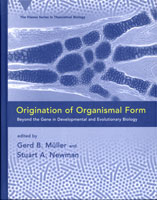







|
|

Müller, G. B., and Newman, S. A., Eds.
Origination Of Organismal Form: Beyond The Gene In Developmental And Evolutionary Biology,
2003
MIT Press, Cambridge, MA
ISBN 0262134195
- Contents
- I. INTRODUCTION
- 1, Origination of Organismal Form: The Forgotten Cause In Evolutionary Theory, Gerd B. Müller and Stuart A. Newman
- II. PROBLEMS OF MORPHOLOGICAL EVOLUTION
- 2, The Cambrian "Explosion" of Metazoans, Simon Conway Morris
- 3, Convergence and Homoplasy in the Evolution of Organismal Form, Pat Willmer
- 4, Homology: The Evolution of Morphological Organization, Gerd B. Müller
- III. RELATIONSHIPS BETWEEN GENES AND FORM
- 5, Only Details Determine, Roy J. Britten
- 6, The Reactive Genome, Scott F. Gilbert
- 7, Tissue Specificity: Structural Cues Allow Diverse Phenotypes from a Constant Genotype, Mina J. Bissell, I. Saira Mian, Derek Radisky, and Eva Turley
- 8, Genes, Cell Behavior, and the Evolution of Form, Ellen Larsen
- IV. PHYSICAL DETERMINANTS OF MORPHOGENESIS
- 9, Cell Adhesive Interactions and Tissue Self-Organization, Malcolm Steinberg
- 10, Gradients, Diffusion, and Genes in Pattern Formation, H. Frederik Nijhout
- 11, A Biochemical Oscillator Linked to Vertebrate Segmentation, Olivier Pourquié
- 12, Organization through Intra-Inter Dynamics, Kunihiko Kaneko
- 13, From Physics to Development: The Evolution of Morphogenetic Mechanisms, Stuart A. Newman
- V. ORIGINATION AND EVOLVABILITY
- 14, Phenotypic Plasticity and Evolution by Genetic Assimilation, Vidyanand Nanjundiah
- 15, Genetic and Epigenetic Factors in the Origin of the Tetrapod Limb, Günter P. Wagner and Chi-hua Chiu
- 16, Epigenesis and Evolution of Brains: From Embryonic Divisions to Functional Systems, Georg F. Striedter
- 17, Boundary Constraints for the Emergence of Form, Diego Rasskin-Gutman
- Preface
- Concepts concerning the evolution of biological form are undergoing ferment. The vast progress made in the last two decades in characterizing the genetic mechanisms involved in embryonic development has demonstrated unexpected degrees of functional redundancy in these processes and unanticipated discordances between conserved forms and conserved genes. At the same time, evolutionary studies have revealed the surprising extent of homoplasy and other forms of parallel morphological evolution in disparate lineages; they have found evidence of extensive morphological diversity much earlier in the evolution of multicellular life than previously thought. Finally, theoretical models have suggested that certain regimes of natural selection can lead to extensive "rewiring" of genetic circuitry with no overt change in organismal phenotype. These findings have raised new questions concerning the relationship between gene content and activity and the generation of biological form.
- The present volume is motivated by the conviction that the origination of morphological structures, body plans, and forms should be regarded as a problem distinct from that of the variation and diversification of such entities (the central theme of current neo-Darwinian theory) and that the generative determinants of organismal phenotype must be included in any productive account of the evolution of developmental systems and organismal form in our postgenomic era. It is an outgrowth of the 1999 Altenberg workshop in theoretical biology "The Origins of Organismal Form," organized by the Konrad Lorenz Institute for Evolution and Cognition Research (KLI). The workshop brought together scientists in fields ranging across paleontology, developmental biology, developmental and population genetics, cancer research, physics, and theoretical biology whose work has in various ways attempted to supply the missing generative element in standard accounts of the development and evolution of biological form. Despite the wide diversity of the participants' fields of research, three days of discussion only strengthened an initial sense that gene-level descriptions and analyses are just part of the story in development and evolution, that increased attention must be paid to the generative mechanisms, and that computational models will play an important role in the analysis and understanding of the properties and potentialities of generative systems, thus paving the way for formal integration into evolutionary theory.
- We thank the staff of the KLI for their enthusiastic assistance in organizing the workshop. The institute's beautiful setting and a workshop format conducive to the exchange of ideas and controversial views combined to create a uniquely satisfying intellectual experience. As before, it was our great pleasure to work with MIT Press in preparing this volume, and we particularly thank Robert Prior for his continued support of the series.
|
|


Developmental Biology
Published by Elsevier Science under Auspices of Society for Developmental Biology |












